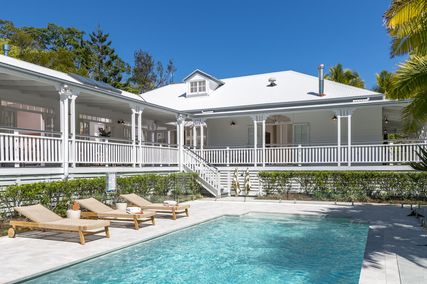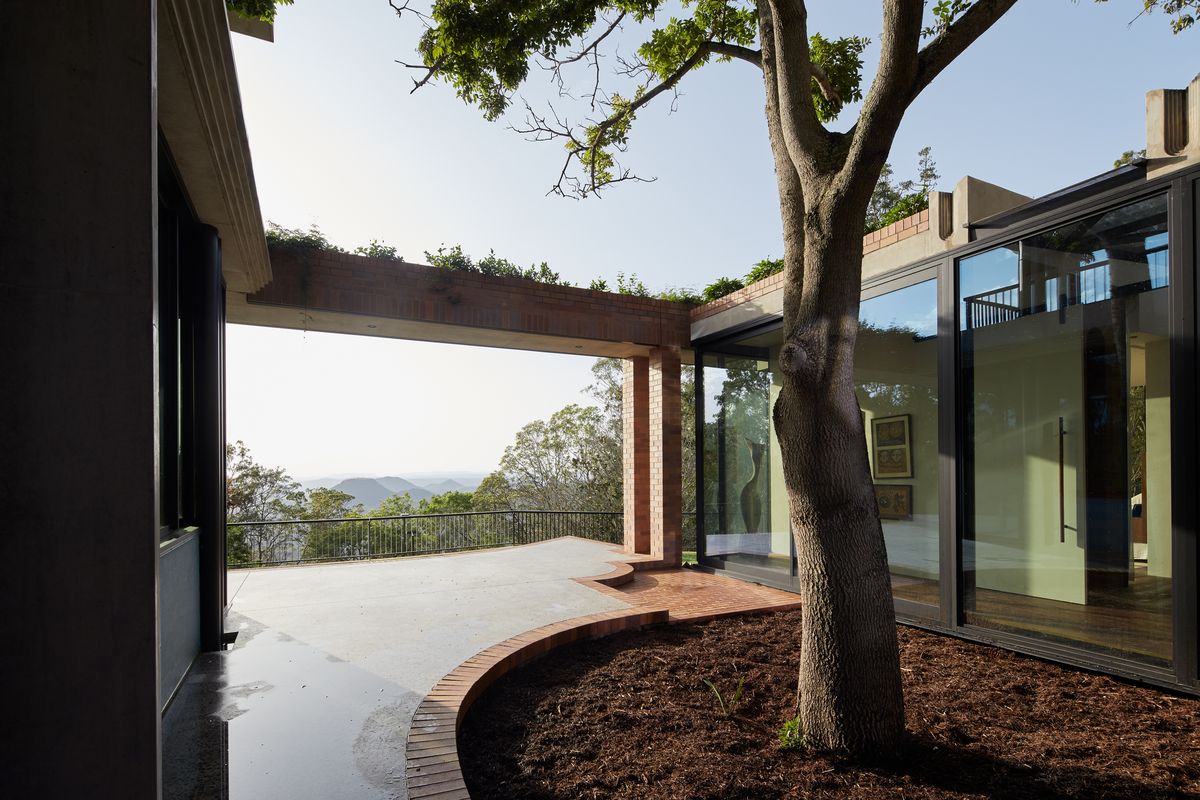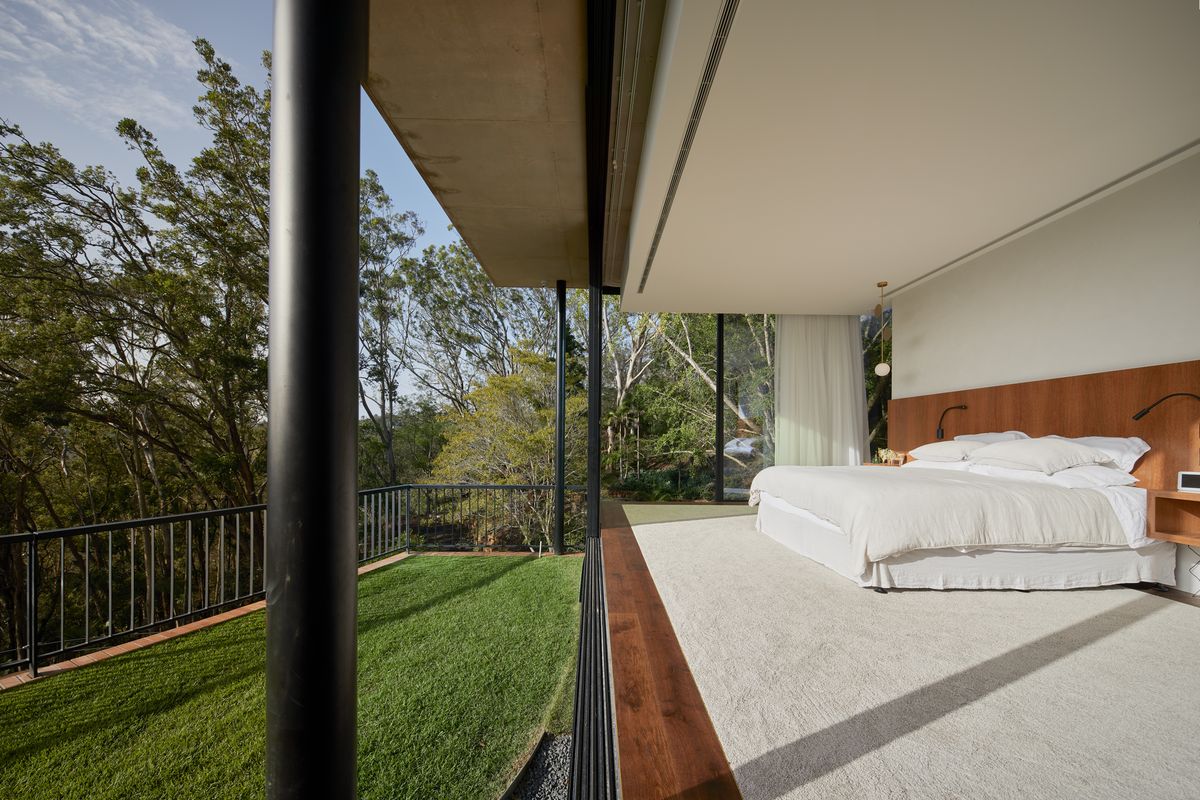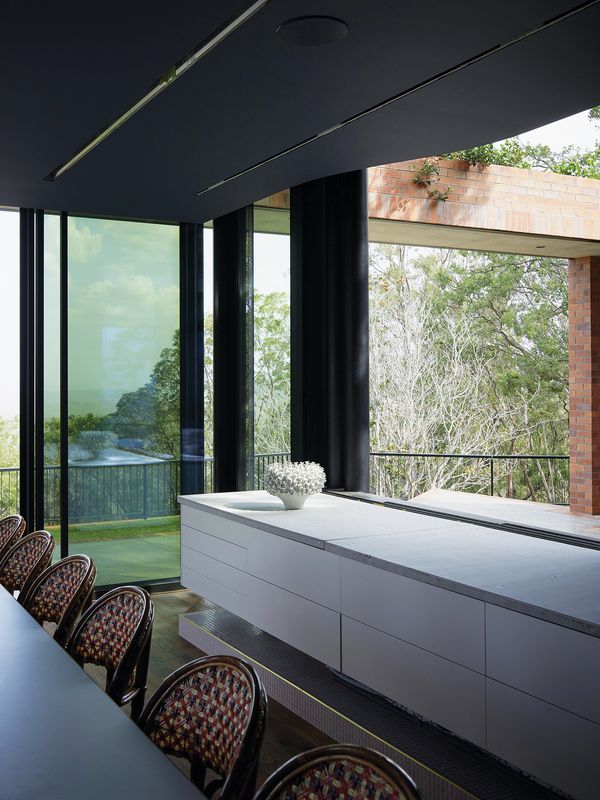A skilled architect and builder, Jesse Bennett established Jesse Bennett Studio with his partner Anne-Marie Campagnolo, an accomplished interior designer, in 2010. Their first project, Planchonella House in Cairns, proved their talent when it was awarded the Australian Institute of Architects’ Robin Boyd Award, as well as the Houses Award for Australian House of the Year, in 2015. The project became a fascination for publishers, featuring in print across Africa, Europe, Asia and America. A review in Houses 104 piqued the interest of another Queensland-based family, prompting them to engage the studio to transform their own historic site in Toowoomba. Known as Tjuringa House, it was to be Jesse and Anne-Marie’s most ambitious project to date.
The project was named by the clients, who suggested the site was akin to an Indigenous Tjuringa, or artefact, carved with motifs and patterns communicating “mythological dreaming, stories of man and great mythic beings.” From the outset, there were ambitions for the site to serve a public function, welcoming garden tours into the generous grounds and emerging sculpture park. Serendipitously, the architecture has evolved into something of a sculpture itself, best experienced from vantage points dotted around the gardens.
Tjuringa House by Jesse Bennett Studio is experienced from multiple vantage points dotted around the garden.
Image: Kristoffer Paulsen
The site is significant for both its size and its position on the precipice of Toowoomba’s Great Dividing Range escarpment. The original two-storey homestead, constructed in 1954 in a style reminiscent of the English Arts and Crafts movement, was something of a recognizable local landmark. Jesse’s initial design sought to preserve the home’s masonry envelope, radically refurbish the interior and introduce a concrete superstructure to sit over existing walls to awaken new connections to landscape and sunlight. But when the team discovered that the existing brick walls could not withstand the described interventions, a radical redesign ensued. They resolved to preserve the building’s original perimeter by reinstating its form with new masonry walls and to salvage and re-use the terracotta roof tiles in appreciation of the building’s history and the weathered patina of its original materials.
With the concrete superstructure remaining a crucial element of the scheme, it transitioned from being an overlay component to becoming the first structure to emerge from the ground. With the building expressed as two distinct elements – masonry shell and concrete roof – suddenly, the concrete had become the ruin and the new masonry walls the contemporary home taking up shelter within it. The concrete roof grounds the building in the landscape, shielding it from both westerly winds and prying eyes from the street above. Like a forest canopy, it establishes an overarching shelter while asserting the horizontality of the garden terrace and horizon.
Tjuringa House by Jesse Bennett Studio is expressed as a masonry shell with a concrete roof
Image: Kristoffer Paulsen
The architecture is a joyous collision of material, craft and geometry. At the northern corner of the house, closest to the approach, an extraordinary junction resolves an intriguing crucifix form. Slender brick arches support a two-storey, L-shaped concrete column that extends beyond the top of the slab to emerge like a pair of inverted obelisks etched out by ziggurat cutaways. It is impossible not to draw comparisons to Carlo Scarpa’s Brion-Vega Cemetery, a building that explores motifs rigorously, overlaying and repeating simple geometries with an unapologetic relentlessness. Here, Jesse Bennett Studio demonstrates a similar obsession with motif, texture and concrete acrobatics.
When pressed to describe the genesis of such architectural motifs, Jesse suggests they emerged almost involuntarily. “[They are] something that recurs organically through our design process,” he muses. What they do reveal is a masterful understanding of making and material. The repeated ziggurat motifs forming edges and tops to concrete elements stand as small reminders that these details were formed with care, by human hands. With such gestures, the architect finds a way to connect this artefact of monumental, civic scale with the palm of a human hand.
New masonry walls preserve the original perimeter of the English Arts and Crafts-style house that formerly occupied the site.
Image: Kristoffer Paulsen
Clay masonry and tile also appear in rather gravity-defying ways. The latter forms the feathered walls enveloping the main bedroom suite, enriched by a visual tapestry of glazing and lichen. Masonry acts as container, but also becomes the crucial material defining landscape edges and raised planter beds. Along the building’s eastern edge, a raised brick planter marches along the entire frontage. Held aloft by twin brick columns, it appears like a kind of viaduct, carrying water and supporting growth both deliberate and random. One imagines that, with time, the brick container will disappear as landscape consumes it.
It is rare for a residential building to transcend both function and time but Jesse and Anne-Marie have achieved that here. “The building will play with time and we hope for it not to be from any distinguishable period or style of architecture,” says Jesse. “Roof gardens and plantings [will] help soften the hard edges and become overgrown, creating intrigue and delight; a relic to be discovered, explored and reinterpreted.”
Products and materials
- Roofing
- Euroclad zinc roofing; concrete
- External walls
- PGH Bricks and Pavers bricks in ‘Black and Tan’ and ‘Copper Glow’; concrete
- Internal walls
- Plaster in Dulux ‘Berkshire White’ paint finish; PGH Bricks and Pavers bricks in ‘Black and Tan’ and ‘Copper Glow’
- Windows
- Architectural Window Systems aluminium windows and doors
- Flooring
- Agglotech terrazzo tiles in ‘Multicolor Grigio’; Mafi oak timber floors; Godfrey Hirst Decor Plush carpet
- Lighting
- Atelier Areti Mobilia lights
- Kitchen
- V-Zug oven, cooktop and microwave; Franke sinks from Winning Appliances; Gessi Oxygene kitchen mixer; custom joinery in Dulux ‘Berkshire White’ paint finish; ceiling in Dulux ‘Marshal Blue’ paint finish; Inax Accordi U and Hacienda tiles, and Maximum pressed porcelain panels, from Artedomus
- Bathroom
- Maximum pressed porcelain panels from Artedomus; Fantini Rubinetti tapware in ‘Matt British Gold’
- External elements
- Swimming pool by Rogers Pools
Credits
- Project
- Tjuringa House
- Architect
- Jesse Bennett Architect
Cairns, Qld, Australia
- Project Team
- Jesse Bennett, Anne-Marie Campagnolo
- Consultants
-
Builder
Mark Ross Timber Homes
Engineer Optimum Structures
Landscape design Cloudlake Design
Lighting Ashburner Francis
- Aboriginal Nation
- Tjuringa House is built on the land of the Barunggam people
- Site Details
-
Location
Toowoomba,
Qld,
Australia
Site type Rural
Site area 26038 m2
Building area 723 m2
- Project Details
-
Status
Built
Completion date 2019
Design, documentation 18 months
Construction 30 months
Category Residential
Type New houses
Source

Project
Published online: 24 Aug 2020
Words:
Michelle Bailey
Images:
Kristoffer Paulsen
Issue
Houses, August 2020






























